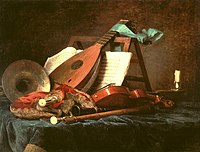
Luis Meléndez (1716–1780), Still Life with Apples, Grapes, Melons, Bread, Jug and Bottle
The bulk of Anne Vallayer-Coster’s work was devoted to the language of still life as it had been developed in the course of the seventeenth and eighteenth centuries. During these centuries, the genre of still life was placed lowest on the hierarchical ladder. Vallayer-Coster had a way about her paintings that resulted in their attractiveness. It was the "bold, decorative lines of her compositions, the richness of her colours and simulated textures, and the feats of illusionism she achieved in depicting wide variety of objects, both natural and artificial" which drew in the attention of the Royal Académie and the numerous collectors who purchased her paintings. This interaction between art and nature was quite common in Dutch, Flemish and French still lifes. Her work reveals the clear influence of Jean-Baptiste-Siméon Chardin, as well as 17th-century Dutch masters, whose work has been far more highly valued, but what made Vallayer-Coster’s style stand out against the other still-life painters was her unique way of coalescing representational illusionism with decorative compositional structures.
The end of the eighteenth century and the fall of the French monarchy closed the doors on Vallayer-Coster’s still-life ‘era’ and opened them to her new style of florals. It has been argued that this was the highlight of her career and what she is best known for. However, it has also been argued that the flower paintings were futile to her career. Nevertheless, this collection contained floral studies in oil, watercolour and gouache.

Carl Hofverberg (1695–1765), Trompe l'oeil (1737), Foundation of the Royal Armoury, Sweden
| 
Jean-Baptiste-Siméon Chardin, Still Life with Glass Flask and Fruit (c. 1750)
| 
Jean-Baptiste Oudry, The White Duck (1753), stolen from Houghton Hall in 1990
| 
Rachel Ruysch, Roses, Convolvulus, Poppies, and Other Flowers in an Urn on a Stone Ledge (1680s)
|
|---|---|---|---|

Anne Vallayer-Coster, The Attributes of Music (c. 1770)
| 
Carlo Manieri, Still Life with Silverware, Pronkstilleven (1662-1700)
| 
Anne Vallayer-Coster, Still Life With Lobster (c. 1781)
| 
Anne Vallayer-Coster, The Attributes of Painting (c. 1769)
|
A still life is a work of art depicting mostly inanimate subject matter, typically commonplace objects which are either natural (food, flowers, dead animals, plants, rocks, shells, etc.) or man-made (drinking glasses, books, vases, jewelry, coins, pipes, etc.).
With origins in the Middle Ages and Ancient Greco-Roman art, still-life painting emerged as a distinct genre and professional specialization in Western painting by the late 16th century, and has remained significant since then. A still-life form gives the artist more freedom in the arrangement of elements within a composition than do paintings of other types of subjects such as landscape or portraiture. Still life, as a particular genre, began with Netherlandish painting of the 16th and 17th centuries, and the English term still life derives from the Dutch word stilleven. Early still-life paintings, particularly before 1700, often contained religious and allegorical symbolism relating to the objects depicted. Some modern still-life work breaks the two-dimensional barrier and employs three-dimensional mixed media, and uses found objects, photography, computer graphics, as well as video and sound.
The term includes the painting of dead animals, especially game. Live ones are considered animal art, although in practice they were often painted from dead models. The still-life category also shares commonalities with zoological and especially botanical illustration, where there has been considerable overlap among artists. Generally a still life includes a fully depicted background, and puts aesthetic rather than illustrative concerns as primary.
Still life occupied the lowest rung of the hierarchy of genres, but has been extremely popular with buyers. As well as the independent still-life subject, still-life painting encompasses other types of painting with prominent still-life elements, usually symbolic, and "images that rely on a multitude of still-life elements ostensibly to reproduce a 'slice of life'". The trompe-l'œil painting, which intends to deceive the viewer into thinking the scene is real, is a specialized type of still life, usually showing inanimate and relatively flat objects.
Source From Wikipedia
没有评论:
发表评论